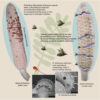The shrew’s resting heart rate can reach up to 17 beats per second, equivalent to about 1,020 beats per minute. In comparison, the average human resting heart rate is around 60 to 100 beats per minute, making the shrew’s resting heart rate approximately 10–17 times higher than that of humans.
Until now, it has been a mystery how these small mammals achieve such an extreme resting heart rate, but a new study, just published in the journal Science, sheds light on the mystery.
An international research team led by postdoc William Joyce, during his time at Aarhus University (AU), and Professor Kevin Campbell, previously affiliated with AU and now at the University of Manitoba (Canada), has investigated how evolutionary changes in the heart protein “cardiac troponin I” have enabled shrews to achieve their unusually high resting heart rate.
“We discovered that a crucial part of the heart protein that regulates heart relaxation time is missing in shrews and closely related moles. This evolutionary loss permanently removes the brakes on heart relaxation, allowing their hearts to beat much faster,” explains Joyce, now working at The Centro Nacional de Investigaciones Cardiovasculares Carlos III (CNIC) in Spain.
A missing DNA region
The protein plays a vital role in the heart’s ability to bind calcium ions during contraction. Calcium ions are necessary for the heart muscle to contract and are therefore critical for heart function.
In other mammals, this protein contains two specific serine amino acids that are temporarily modified when the heart is stimulated by hormones such as adrenaline, released during stress or physical activity. This modification helps the heart’s muscle fibers release calcium ions more quickly after contraction, allowing the heart muscle to relax faster and giving the heart more time to fill with blood between beats.
However, an evolutionary change has occurred in shrews.
“In an early ancestor of shrews, the DNA region encoding the two serines became inactivated. This means the protein always functions as if it were activated by adrenaline, even when the animal is at rest, allowing shrews to achieve their extreme heart rates,” explains Campbell.
Bats map the evolutionary path
The researchers also studied the heart protein in bats, which, like shrews, can reach heart rates exceeding 1,000 beats per minute. This provided them with a better understanding of how the ability for high heart rates evolved.
“Our analysis shows that some bat species can skip over the part of the gene that codes for the two serine amino acids when the protein is formed. Ancient shrews and moles likely had the same ability, and evolution gradually favored their troponin I proteins to completely lose this region. This permitted them to evolve even higher heart rates,” explains Campbell.
The research team’s next goal is to explore how the findings can be translated into biomedicine. “This means replicating the splicing of troponin I, as observed in bats, in model organisms and potentially—eventually—in human hearts to mimic the beneficial effects,” says Joyce.
More information:
William Joyce et al, Genetic excision of the regulatory cardiac troponin I extension in high–heart rate mammal clades, Science (2024). DOI: 10.1126/science.adi8146
Citation:
Protein study reveals how the tiny shrew achieves a resting heart rate of 1,020 beats per minute (2024, September 30)



